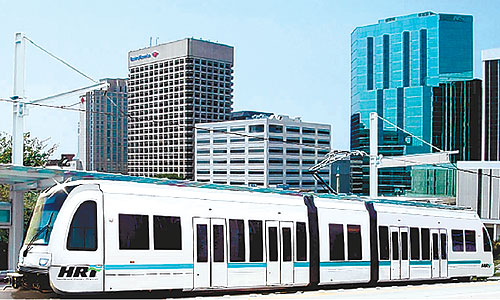The United States is reducing its dependency on oil as we now consuming 18.3 million barrels a day, down from our peak of 21 million barrels a few years ago. Record use of public transit is a major factor – less solo driving in gridlock and we use less oil. Other major factors, of course, include high gasoline prices and more fuel-efficient cars. Since 96 percent of our transportation is from oil refined into gasoline, diesel, and jet fuel, we will take all the help we can get.
According to a report released today by the American Public Transportation Association (APTA), Americans took 10.4 billion trips on public transportation in 2011, the second highest annual ridership since 1957. Only ridership in 2008, when gas rose to more than $4 a gallon, surpassed last year’s ridership. With an increase of 2.3 percent over the 2010 ridership, this was the sixth year in a row that more than 10 billion trips were taken on public transportation systems nationwide. During 2011, vehicle miles of travel (VMTs) declined by 1.2 percent.
A number of U.S. regions demonstrated leadership in improving bus and rail systems, often doing more with less. The best systems use rail as the backbone of the system integrated with more cost-effective bus.
Light rail systems that showed major increases in 2011 include these regions: Seattle, WA up 37.2%, Dallas, TX up 31.2%; Buffalo, NY up 15.6; North San Diego County up 14.8%; Salt Lake City, UT up 14.4%. These rail systems use local electricity, not foreign oil.
Cities with highest transit ridership use heavy rail (subways and elevated trains) to move millions. Heavy rail systems 2011 ridership growth was greatest in Cleveland, OH (12.3%), San Juan, PR (12%), Baltimore, MD (8.7%), Boston, MA (7.2%), San Francisco, CA (5.6%), Chicago, IL (5%), Miami, FL (4.9%), New York, NY (4.9%), and Philadelphia, PA (4.7%).
Buses, including bus rapid transit, are the heart of getting riders to their final destination. Cleaning the air and improving U.S. energy independence, most new buses are hybrid or run on natural gas. Bus systems with largest 2011 growth include Columbus, OH (10.1%), Saint Louis, MO (10%), Orlando, FL (8.4%), Miami, FL (8.3%), Washington, DC (7.1%), San Diego, CA (6.8%), San Antonio, TX (6.3%), Arlington Heights, IL (4.6%), Minneapolis, MN (4.3%), and Baltimore, MD (3.9%).
“U.S. public transportation ridership in 2011 is now the second highest ridership since 1957,” said APTA President and CEO Michael Melaniphy. “What is exciting is that the uptick in ridership occurred in large, medium and small communities, showing the broad support that public transportation has nationwide. In fact, the largest rate of growth was in rural communities with populations under 100,000 where public transit use increased by 5.4 percent.”
“Two top reasons for the increased ridership are higher gas prices and in certain areas, a recovering economy with more people returning to work,” said Melaniphy. “Since nearly sixty percent of trips taken on public transportation are for work commutes, it’s not surprising to see ridership increase in areas where the economy has improved.”
Transit also helps car drivers by relieving gridlock. Transit helps reduce the burden on taxpayers to widen highways and expressways. Most tax-payer transportation funds go to widen highways. Transit is funded by federal, state, local, and rider fares.
It is an election year. Congressional Republicans tried and failed to only continue funding transit if states were forced to approve offshore drilling everywhere and approve eminent domain for the XL pipeline. That effort failed, but transit is still threatened with budget cuts and regional shutdowns. “There should be no doubt Americans need and want public transportation,” said Melaniphy. “Congress needs to pass a well funded, multimodal, multi-year transportation bill that will help meet current and growing demand.”
Fortunately, Americans act smart, even when Congress acts dumb. Millions look at smart apps like Google Maps and compare driving with transit. In a given week, more people intelligently mix transit, driving solo, driving with others, and some healthy walking. More smarts, less oil.
APTA 2011 Ridership Report PDF
Ten Ways to Reduce U.S. Dependency on Oil

